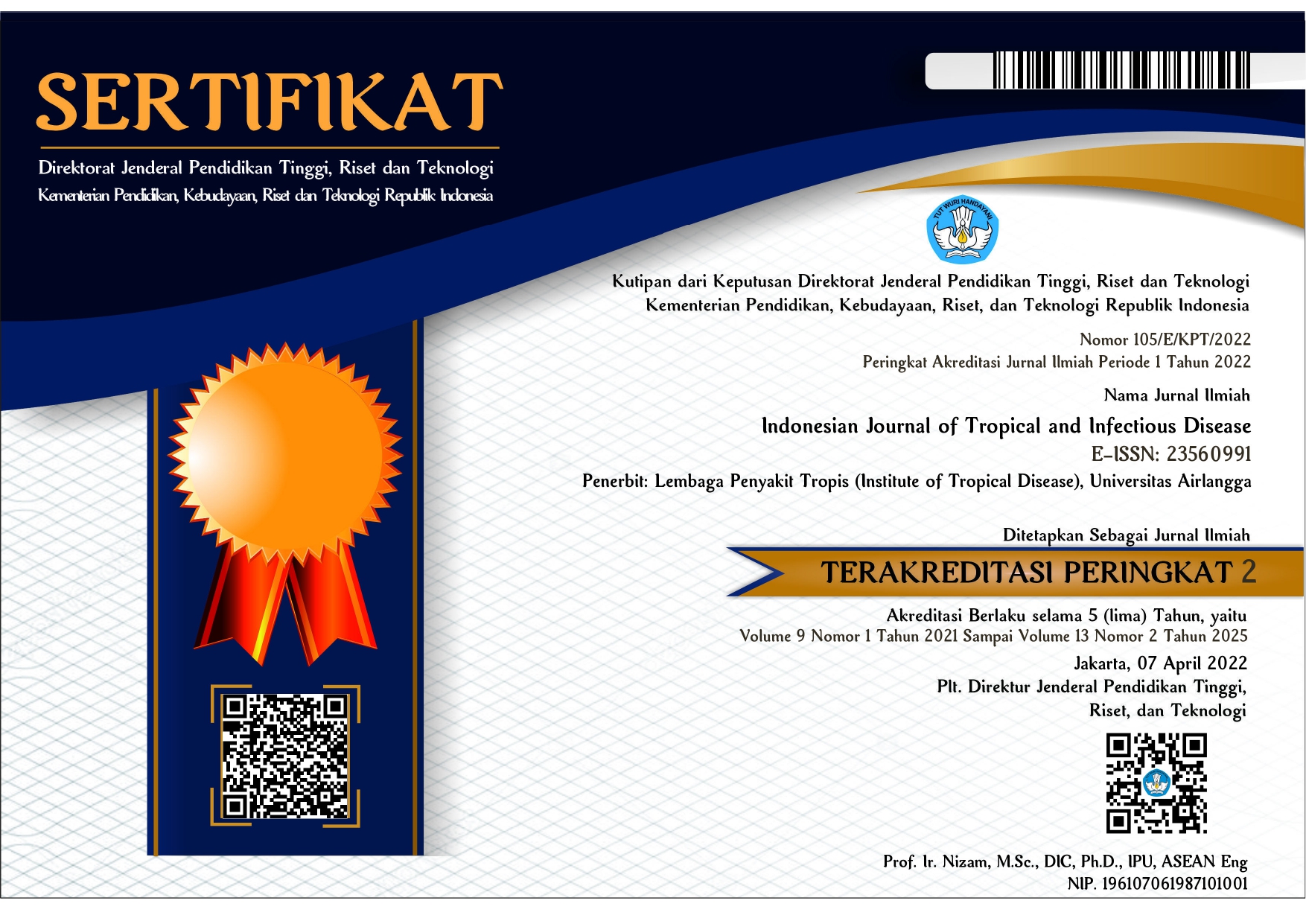Effect of Fetal Bovine Serum Concentration on Detection and Morphological Identification of Blastocystis hominis in vitro
Downloads
Diarrhea significantly contributes to the high rates of illness and death among young children. Diarrhea can be caused by bacterial infections, viruses, or even parasites. Blastocystis hominis causes parasitic diarrhea, which can be identified by microscopy, culture, and molecular methods. Previous reports have modified the Jones’ culture medium using three different serums, such as human plasma, donkey serum, and horse serum (in Jones’ medium). This research replaces horse serum with fetal bovine serum for detection tests, morphological observation, and diagnosis of B. hominis. The research encompasses five experimental groups, each subjected to varying concentrations of fetal bovine serum: 2%, 10%, 20%, 30%, and 40%. Detection analysis is conducted using the Mc-Nemar test, while the Wilcoxon test is applied to evaluate ordinal data from morphological assessments. Diagnostic tests and metrics such as accuracy, sensitivity, specificity, positive predictive value (PPV), and negative predictive value (NPV) are performed using MedCalc® software. The findings demonstrate that serum concentrations of 2%, 10%, 20%, and 30% produced effective results in detection tests, morphological identification, and diagnostic evaluations of B. hominis, exhibiting high sensitivity, specificity, PPV, NPV, and accuracy. Fetal bovine serum can be used at a concentration of 2% in a Jones’ medium that has been modified. This depends on the results of detection tests, morphology, and diagnosis.
World Health Organization. Diarrhoeal Disease. 2024. Available from: https://www.who.int/newsroom/fact-sheets/detail/diarrhoealdisease.
Sumampouw OJ, Nelwan JE, Rumayar AA. Socioeconomic factors associated with diarrhea among under-five children in Manado Coastal Area, Indonesia. J Glob Infect Dis 2019;11(4):140–146; doi: 10.4103/jgid.jgid_105_18.
UNICEF. Diarrhoea. 2024.
Kemenkes RI DP. Laporan Kinerja Direktorat P2P Tahun 2022. 2022;62–69.
Khalil IA, Troeger C, Blacker BF, et al. Morbidity and mortality due to shigella and enterotoxigenic Escherichia coli diarrhoea: the Global Burden of Disease Study 1990–2016. Lancet Infect Dis 2018;18(11):1229–1240; doi: 10.1016/S1473-3099(18)30475-4.
Troeger C, Blacker BF, Khalil IA, et al. Estimates of the global, regional, and national morbidity, mortality, and aetiologies of diarrhoea in 195 countries: a systematic analysis for the Global Burden of Disease Study 2016. Lancet Infect Dis 2018;18(11):1211–1228; doi: 10.1016/S1473-3099(18)30362-1.
Kumar V, Abbas AK, Aster JC. Robbins Basic Pathology. Elsevier: Philadelphia: Elsevier; 2015; pp. 576–586.
Anggraini D, Kumala O. Diare Pada Anak. Sci J 2022;1(4):309–317; doi: 10.56260/sciena.v1i4.60.
Rendang Indriyani DP, Putra IGNS. Penanganan terkini diare pada anak: tinjauan pustaka. Intisari Sains Medis 2020;11(2):928–932; doi: 10.15562/ism.v11i2.848.
Mardani Kataki M, Tavalla M, Beiromvand M. Higher prevalence of Blastocystis hominis in healthy individuals than patients with gastrointestinal symptoms from Ahvaz, southwestern Iran. Comp Immunol Microbiol Infect Dis 2019;65(May):160–164; doi: 10.1016/j.cimid.2019.05.018.
Deng L, Chai Y, Zhou Z, et al. Epidemiology of Blastocystis sp. infection in China: A systematic review. Parasite 2019;26; doi: 10.1051/parasite/2019042.
CDC. Blastocystis Sp. 2019. Available from: https://www.cdc.gov/dpdx/blastocystis/index.html.
Anuar TS, Ghani MKA, Azreen SN, et al. Blastocystis infection in Malaysia: Evidence of waterborne and human-to-human transmissions among the Proto-Malay, Negrito and Senoi tribes of Orang Asli. Parasites & vector 2013; doi: 10.1186/1756-3305-6-40.
Alfellani MA, Stensvold CR, Vidal-Lapiedra A, et al. Variable geographic distribution of Blastocystis subtypes and its potential implications. Acta Trop 2013;126(1):11–18; doi: 10.1016/j.actatropica.2012.12.011.
Zierdt CH. Pathogenicity of Blastocystis hominis. J Clin Microbiol 1991; doi: 10.1128/jcm.29.3.662-663.1991.
Vassalos CM, Spanakos G. Differences in Clinical Significance and Morphologic Features of Blastocystis sp Subtype 3. 2010;251–258; doi: 10.1309/AJCPDOWQSL6E8DMN.
Varghese T, Mills JAP, Revathi R, et al. Etiology of diarrheal hospitalizations following rotavirus vaccine implementation and association of enteric pathogens with malnutrition among under-five children in India. Gut Pathog 2024;16(1):1– 10; doi: 10.1186/s13099-024-00599-8.
Padukone S, Mandal J, Rajkumari N, et al. Detection of Blastocystis in clinical stool specimens using three different methods and morphological examination in Jones’ medium. Top Parasitol 2018; doi: 10.4103/tp.TP_4_18.
Kok M, Cekin Y, Cekin AH, et al. The role of Blastocystis hominis in the activation of ulcerative colitis. Turkish J Gastroenterol 2019;30(1):40–46; doi: 10.5152/tjg.2018.18498.
Sari IP, Benung MR, Wahdini S, et al. Diagnosis and identification of Blastocystis subtypes in primary school children in Jakarta. J Trop Pediatr 2018;64(3):208–214; doi: 10.1093/tropej/fmx051.
Hassan, M. A., Rizk, E. M., & Wassef, R. M. Modified culture methodology for specific detection of Blastocystis hominis in stool samples. J Egypt Soc Parasitol 2016;46.
Liu S, Yang W, Li Y, et al. Fetal bovine serum, an important factor affecting the reproducibility of cell experiments. Sci Rep 2023;13(1):1–8; doi: 10.1038/s41598-023-29060-7.
Lehrich BM, Liang Y, Fiandaca MS. Foetal bovine serum influence on in vitro extracellular vesicle analyses. J Extracell Vesicles 2021;10(3); doi: 10.1002/jev2.12061.
Lee DY, Lee SY, Yun SH, et al. Review of the Current Research on Fetal Bovine Serum and the Development of Cultured Meat. Food Sci Anim Resour 2022;42(5):775–799; doi: 10.5851/kosfa.2022.e46.
Farah Haziqah M, Chandrawathani P, Douadi B, et al. Impact of pH on the viability and morphology of Blastocystis isolates. Trop Biomed 2018.
Zhang X, Qiao JY, Wu XM, et al. In vitro culture of Blastocystis hominis in three liquid media and its usefulness in the diagnosis of blastocystosis. Int J Infect Dis 2012;16(1); doi: 10.1016/j.ijid.2011.09.012.
Putnam RW. Intracellular PH Regulation. 2001.; doi: 10.1016/S0070-2161(08)60269-5.
Engelking LR. Protein Structure. Textb Vet Physiol Chem 2015; doi: 10.1016/B978-0-12-391909-0.50004-9.
Sutton SC. Companion animal physiology and dosage form performance. Adv Drug Deliv Rev 2004;56(10):1383–1398; doi: 10.1016/j.addr.2004.02.013.
Copyright (c) 2025 Indonesian Journal of Tropical and Infectious Disease

This work is licensed under a Creative Commons Attribution-NonCommercial-ShareAlike 4.0 International License.
The Indonesian Journal of Tropical and Infectious Disease (IJTID) is a scientific peer-reviewed journal freely available to be accessed, downloaded, and used for research. All articles published in the IJTID are licensed under the Creative Commons Attribution-NonCommercial-ShareAlike 4.0 International License, which is under the following terms:
Attribution ” You must give appropriate credit, link to the license, and indicate if changes were made. You may do so reasonably, but not in any way that suggests the licensor endorses you or your use.
NonCommercial ” You may not use the material for commercial purposes.
ShareAlike ” If you remix, transform, or build upon the material, you must distribute your contributions under the same license as the original.
No additional restrictions ” You may not apply legal terms or technological measures that legally restrict others from doing anything the license permits.























